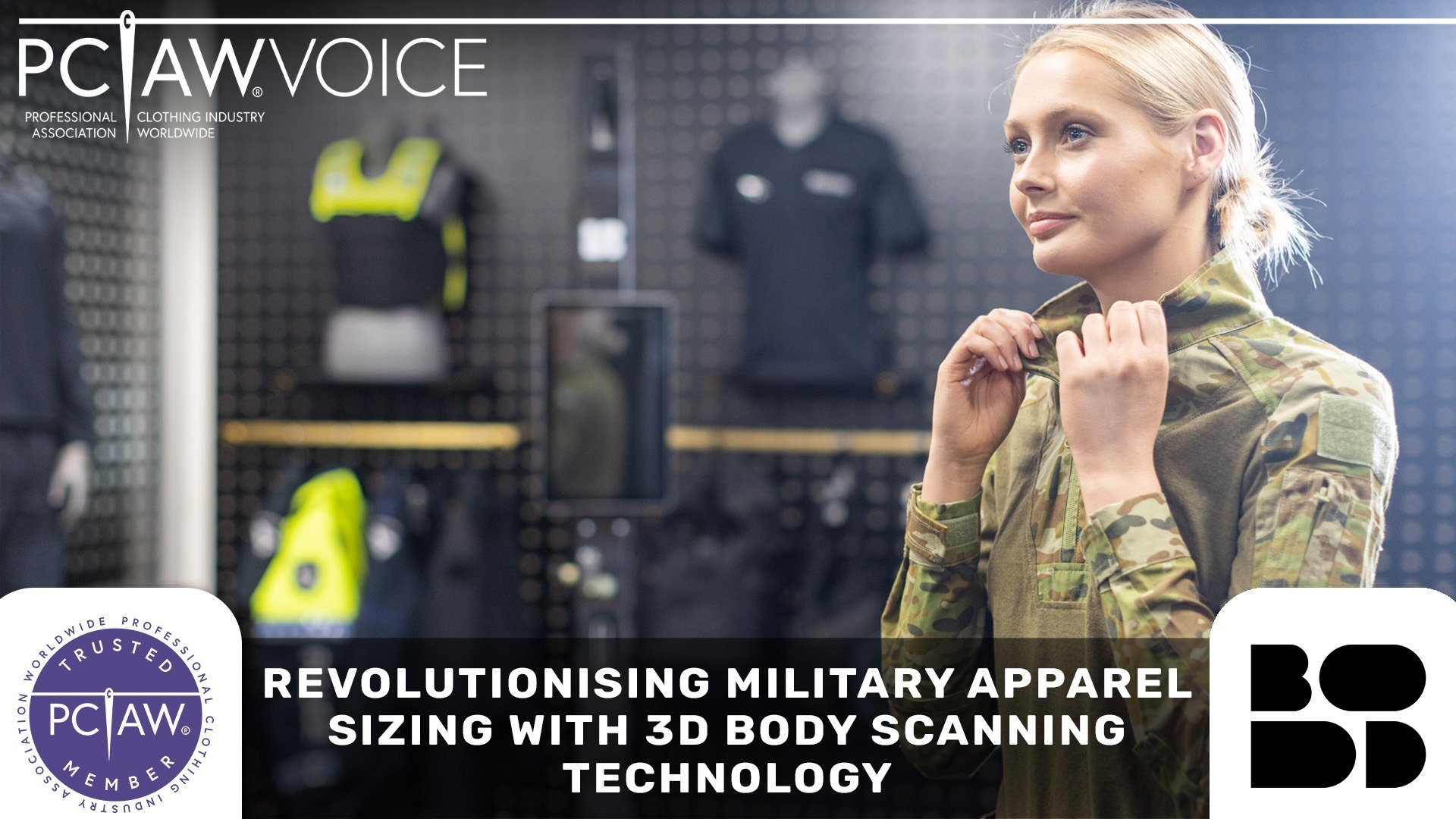
Category: TECHNOLOGY AND INNOVATION
Country: New Zealand
By Jamie Stokes
14th March 2024
In the realm of military operations, having properly fitted apparel is not just about comfort and aesthetics but is also crucial for ensuring optimal performance, mobility, and protection for personnel. Traditional methods of sizing clothing for military personnel have often relied on basic measurements such as height, weight, and manual tape measure measurement.
While traditional methods of taking body measurements with a tape measure have been widely used for apparel sizing, they present several limitations that can compromise accuracy and reliability:
Subjectivity and Human Error: Measuring with a tape measure relies heavily on the skills and consistency of the individual taking the measurements. Human error, such as variations in placement, tension, or interpretation of anatomical landmarks, can lead to inconsistencies and inaccuracies in the recorded measurements. Additionally, factors such as fluctuations in posture, breathing, or muscle tension during measurement can further introduce variability, resulting in imprecise sizing estimations.
Limited Dimensionality: Tape measure-based measurements typically capture only linear dimensions (e.g., chest circumference, waist circumference), neglecting the complex three-dimensional contours and proportions of the human body. As a result, traditional measurements may fail to account for variations in body shape, such as differences in torso length, shoulder width, or curvature of the spine, leading to ill-fitted garments that do not adequately conform to individual anatomy. Moreover, tape measure-based methods may overlook asymmetries or irregularities in body structure, resulting in uniform sizes that fail to accommodate unique physiological characteristics and may cause discomfort or restrict movement.
In addition, these traditional methods may not capture the intricacies of individual body shapes and proportions, leading to ill-fitted uniforms that can hamper performance and compromise safety.
Enter 3D body scanning technology, a revolutionary tool with the potential to transform how military apparel is sized and tailored.
Understanding 3D Body Scanning:
3D body scanning technology involves the use of specialised scanners equipped with multiple sensors to capture detailed measurements of an individual’s body in three dimensions. Scanners such as Bodd, utilise various techniques such as structured light, or photogrammetry to create a highly accurate digital representation of the person’s body shape, contours, and dimensions.
Advantages for Military Apparel Sizing:
Precision: Unlike traditional sizing methods, which rely on limited measurements, 3D body scanning provides a comprehensive and precise analysis of an individual’s body shape. This precision ensures that apparel can be tailored to fit each soldier’s unique physique, enhancing comfort and mobility while minimising issues such as chafing or restricted movement.
Customisation: Military personnel often have diverse body shapes and sizes, and standard-issue uniforms may not accommodate these variations adequately. 3D body scanning allows for the customization of apparel based on individual measurements, ensuring a better fit and improved overall performance in the field.
Rapid Prototyping: With 3D body scanning, digital models of soldiers’ bodies can be quickly generated and used for the design and prototyping of new uniforms or gear. This accelerates the development process, allowing for faster iterations and adjustments based on real-time feedback from end-users.
Injury Prevention: Ill-fitted uniforms can contribute to musculoskeletal injuries, especially during physically demanding tasks or prolonged wear. By accurately capturing body dimensions, 3D body scanning can help identify potential areas of discomfort or strain and facilitate the design of ergonomic apparel that reduces the risk of injuries among military personnel.

Image courtesy & property of Australian Defence Apparel
Implementation Challenges and Solutions:
While the potential benefits of 3D body scanning for military apparel sizing are significant, there are several challenges to overcome during implementation:
Scalability: Deploying 3D body scanning technology across large military organisations with diverse operational requirements and geographical locations can be logistically challenging. However, advancements in portable and automated scanning systems can facilitate widespread adoption and integration into existing supply chain processes.
Data Security: Given the sensitive nature of military personnel data, ensuring robust cybersecurity measures to protect scanned body measurements from unauthorised access or misuse is paramount. Implementing encryption protocols and strict access controls can help safeguard personal information and maintain privacy.
Cost Considerations: Initial investments in 3D body scanning infrastructure and software have traditionally posed financial constraints for military agencies, especially those operating within budgetary limitations. However, long-term cost savings resulting from reduced uniform production errors, minimised downtime for sizing, improved soldier performance, and decreased injury rates can justify the upfront expenses. 3D scanning company Bodd offers a unique pay-per-scan pricing model for its platform that removes the CAPEX barrier for such organisations to begin leveraging such technology.
Incorporating 3D body scanning technology into the sizing and tailoring of military apparel represents a significant advancement in enhancing soldier comfort, performance, and safety. By leveraging precise measurements and customisation capabilities, military organisations can ensure that their personnel are equipped with uniforms that not only fit impeccably but also support optimal functionality in various operational environments. As technology continues to evolve, the integration of 3D body scanning into military supply chains holds the promise of revolutionising how uniforms are designed, produced, and distributed, ultimately enhancing the effectiveness and readiness of armed forces worldwide.

Beyond its application in apparel sizing, 3D body scanning technology can also play a crucial role in supporting the health and wellness of defence personnel:
Body Composition Analysis: 3D body scanning enables the accurate assessment of body composition, including measurements of fat mass, lean mass, and body volume. By regularly monitoring changes in body composition, military health professionals can tailor nutrition and fitness programs to individual needs, promoting optimal physical readiness and overall wellness among personnel. Additionally, this data can aid in identifying trends related to nutritional deficiencies, hydration levels, or potential health risks, allowing for proactive interventions to mitigate issues before they escalate.
Injury Rehabilitation and Prevention: Injuries are a common concern for military personnel, particularly those engaged in physically demanding roles or combat operations. 3D body scanning can facilitate precise monitoring of injury progression, allowing healthcare providers to track changes in affected areas, assess treatment effectiveness, and adjust rehabilitation protocols accordingly. By integrating scanning data with biomechanical analysis and medical imaging techniques, clinicians can develop personalised rehabilitation plans that address specific musculoskeletal issues, promote proper healing, and minimise the risk of re-injury. Furthermore, proactive screening using 3D body scanning may help identify biomechanical imbalances or structural anomalies that predispose individuals to certain injuries, enabling targeted preventive measures such as corrective exercises or equipment modifications.
Learn how Bodd is revolutionising apparel sizing for New Zealand Defence Force (NZDF)
In partnership with Australian Defence Apparel, Bodd’s real-time scanning technology is used to provide instant sizing matched to each service personnel’s measurements.
By matching the scanned proportions of a recruit against the inventory of every item of clothing they require for their duties, a unique database is developed as part of their NZDF record.
The technology drastically reduces resource requirements and significantly speeds up traditional manual fitting processes, according to ADA Chief Executive Officer Chris Dixon.
“ADA’s partnership with Bodd is instrumental in delivering on our commitment to combine leading textiles and new technologies to solve apparel distribution challenges,” he said.
“This revolutionary digital fitting technology allows for a seamless user experience, as it drastically reduces time required for fitting and kitting of defence personnel.”
By harnessing the capabilities of 3D body scanning technology to support both apparel sizing and health management initiatives, military organisations can optimise the well-being, performance, and readiness of their personnel. As part of a holistic approach to personnel care, integrating 3D body scanning into military healthcare systems can also contribute to a culture of proactive health management, empowering individuals to achieve their physical and operational potential while minimising the impact of injury and illness on mission effectiveness.
Courtesy: Pciaw.org
Copyrights © 2026 GLOBAL TEXTILE SOURCE. All rights reserved.